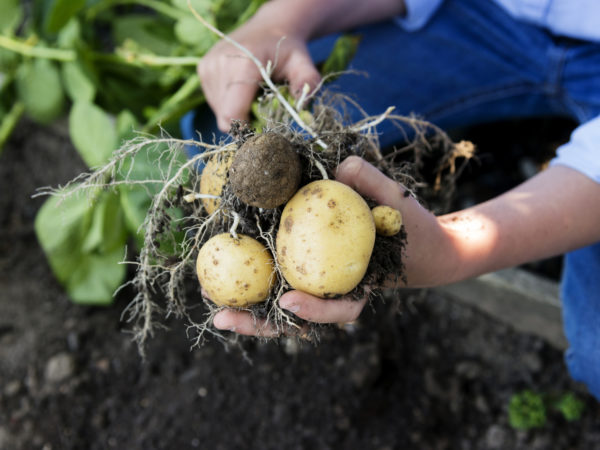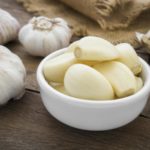Potato Nation

We have the couch potato. Mr. Potato Head. Potato guns. Potato clocks. Potato chips. Potato salad. Potato soup. Au gratin. Mashed. Flaked. Baked. Fried. Twice baked. Oven roasted. Potato pie. Potato mash whiskey. Bonsai potatoes. Hot potato. Potatoes in a box. French fries. Tater tots. Hash browns. Home fries. Idaho gold! With gravy, please. The potato permeates our culture. Dr. Weil straddles the fine line between blasphemy and good sense by suggesting that Americans eat fewer potatoes. And have a smaller piece of apple pie for dessert.
The potato, Solanum tuberosum, is grown for its tubers. The leaves and stem contain a natural toxin called solanine and should not be eaten. If exposed to light, potatoes themselves can turn green, indicating the presence of solanine, but the odd green spot on a potato contains too little to do harm.
Greening, aka chitting, potatoes is the process we use in the garden to get our potato “seeds” off to an early start and is not necessary for main season (summer grown) crops. You’ve undoubtedly greened potatoes by leaving them out on the counter too long. To properly and purposefully green your potatoes, place them in a single layer on a tray with the eyes facing up. The eyes are, of course, the divots in the potato where shoots will emerge. The tray can then be set out in a cool, frost-free area in the light, though out of direct sun. Greening your potatoes should begin early in the year depending on your climate zone. Give them a couple months before the last frost date to green (late January in mild climates and late February in colder areas). They can then be planted, before the last frost is expected, so that the first shoots emerge into a frost-free spring. Potatoes can be planted, greened or not, throughout the spring. If you have limited space, they are also suitable for container gardening.
An open, sunny spot is the best place to plant your potatoes. Give them plenty of room to grow, about a foot between each potato, because the plants grow rather large. The ground should be loosened and the potatoes planted about four inches deep. They prefer soils on the acid side, so do not add lime. No fertilizers or manures should be added directly to the planting to prevent scabbing and blight. After you’ve planted, you can draw up more soil to form a low mound above them. When the shoots are eight to ten inches long, mound up more soil around them, leaving the uppermost three to five inches exposed. Hilling like this encourages tuber production. Continue to hill your potatoes until the foliage is a couple feet across. To feed your crop, side-dress the hills with an organic fertilizer or feed them with a liquid kelp spray.
When the first flowers open above the lush foliage, your early potatoes are ready to harvest. Do not plant potatoes in the same place two years in a row to prevent blight and if you know your tomato plants had blight, avoid this location as well.
There are so many different varieties of potato I won’t even mention one. You can order them from seed suppliers, or you can grow them from potatoes purchased at the market. I strongly recommend growing only organic varieties. Each variety is unique in flavor and texture. Finding a few suitable for your backyard will require some experimentation. “New” potatoes are merely immature, usually early varieties. Fingerlings are long, finger-shaped potatoes. Different varieties are suitable for different dishes, whether for boiling, frying, baking or making salads.
The tuber, as with all bulbs, is a food storage system for the plant. These starches, the part we primarily eat, are not the most nutritious part of the tuber. The fibrous skin and the layer directly beneath contain most of the nutrients of the potato, which include vitamins B6 and C, niacin, potassium, iron, magnesium and pantothenic acid. Baking or roasting your potatoes is a much healthier way of cooking them than eating them fried.
The potatoes’ cultivation spread throughout Europe following the Spanish invasion of South America. Eventually cultivars were developed suitable for growing in the British Isles. The large scale planting of potatoes in Ireland, an early example of the problems inherent in mono-cropping, lead to the tragic Irish Potato Famine of 1846-1850. The mass exodus of Irish to Britain and America shaped the history of the English speaking world. “Potato eaters,” a derogatory term for the Irish immigrants, introduced new varieties and popularized the potato in America. Similarly, The Papago Indians, native to Southern Arizona, are known today as the Tohono O’odham, as Papago was a Spanish insult meaning “bean eaters.”
Today, the true potato-eaters are everyday Americans, who eat more potatoes than any other vegetable. As for eating French fries, I’ll quit tomorrow. I just need one more.
By Jace Mortensen, Guest Commentator
DrWeil.com News











